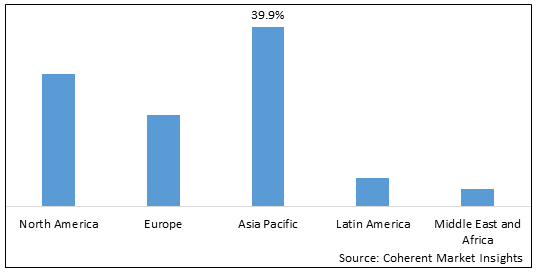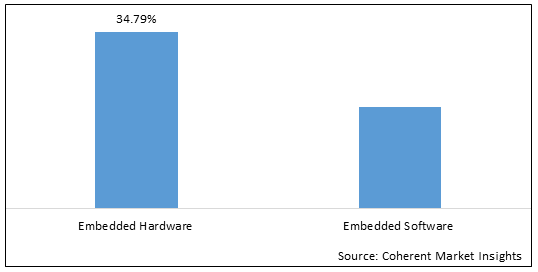
Automotive Embedded Systems Market is estimated to be valued at USD 10.79 Bn in 2025 and is expected to reach USD 16.22 Bn in 2032, exhibiting a compound annual growth rate (CAGR) of 6.0% from 2025 to 2032. It includes microphones, single-chip microcontrollers like cortex, and others.
Some major growth factors for the market are the rising demand for electric vehicles and the growing trend of vehicle electrification in the auto industry. Some major growth factors for the market are the rising demand for electric vehicles and the trend toward vehicle electrification in the auto industry. The development of the appropriate embedded system contributed to the expansion of the automotive embedded system market as a result of the rising popularity of electric vehicles.
Global Automotive Embedded Systems Market- Regional Insights
From 2025 to 2032, the latest Global Automotive Embedded Systems Market forecast predicts that Asia-Pacific will hold the largest share. This is due to an increase in the use of in-vehicle electronics and the presence of major automakers in countries like China, Japan, South Korea, and India.
The demand for automotive embedded systems in Asia-Pacific is also being fueled by an increase in the implementation of advanced automotive technologies like wireless connectivity, multi-modal inputs, driver monitoring systems (DMS), human-machine interface (HMI) communication, and smart cabin monitoring.
Figure 1. Global Automotive Embedded Systems Market Share (%), By Region, 2025

To learn more about this report, Download Free Sample
Global Automotive Embedded Systems Market- Impact of Coronavirus (COVID-19) Pandemic
The outbreak of COVID-19 outbreak adversely affected the growth of the automotive embedded systems in automobile market to some extent, due to disruption in supply and demand chain overall the automotive value chain. Despite the initial setbacks, the automotive industry has shown resilience and adaptability. As lockdown measures eased and vaccination campaigns progressed, automotive production and consumer demand began to recover. Additionally, the pandemic highlighted the importance of connected and autonomous technologies in vehicles, such as infotainment systems and advanced driver assistance systems (ADAS). This recognition could lead to an increased focus on the development and adoption of automotive embedded systems in the post-pandemic era.The pandemic brought about changes in consumer preferences and priorities. Many individuals shifted their focus towards essential items and services, reducing their spending on non-essential goods like new vehicles. This shift in consumer behavior impacted the demand for automotive embedded systems, as it was not considered an immediate necessity by many potential car buyers.
Global Automotive Embedded Systems Market- Drivers
Increasing Demand for Infotainment
The scope of infotainment systems is expanding to include more safety features, additional functionality, and entertainment options for car occupants in light of the evolving mobility industry. Through Wi-Fi and Bluetooth connectivity, users of smartphones can access messages and information, making it easier to work while on the go. With digital assistants, multiple screens, and a variety of input options, these infotainment systems provide a digital experience in automobiles. The joining of computerized interfaces permits auto providers and OEMs to make interfaces that show continuous information in a more reasonable way. Additionally, the digital interfaces grant manufacturers access to a wider range of functions, making it possible for them to carry out a variety of safety-critical functions, such as Advanced Driver Assistance Systems (ADAS). For Instance, example is the Tesla Model S. All the information needed to remotely and immediately assist the driver with almost any vehicle-related issue is sent to the Tesla cloud, eliminating the need for the driver to physically be there. Customer feature and service updates are possible with a connected infotainment system.
Global Automotive Embedded Systems Market- Opportunities
The automotive embedded system market is currently growing at a rapid pace. This is due to the increasing demand for advanced vehicles equipped with various safety and comfort features. Embedded systems are playing a vital role in providing these features.
Some of the major market opportunities for automotive embedded systems are:
Advanced driver assistance systems (ADAS)
ADAS is one of the key areas of focus for automotive manufacturers and suppliers. These systems provide adaptive cruise control, blind spot detection, and lane departure warning by making use of a variety of sensors and cameras. For instance, Continental AG, a multinational German manufacturer of automotive parts, introduced new sensors in May 2022 to safeguard the battery of electrified vehicles. By introducing two brand-new sensors for electrified vehicles, Continental is expanding its extensive sensor portfolio: the battery impact detection system (BID) and the current sensor module (CSM).
In March 2022, Renesas Electronics Corporation,( Japanese semiconductor manufacturer) announced the expansion of its collaboration with Honda in the field of advanced driver-assistance systems (ADAS). Honda adopted Renesas' R-Car automotive system on a chip (SoC) and RH850 automotive MCU for its Honda SENSING Elite system featured in the Legend, which went on sale in March 2021. Honda SENSING Elite incorporates advanced technology that qualifies for Level 3 automated driving
Connected cars
Connected cars are another major growth area for automotive embedded systems. These systems enable vehicles to connect to the internet and exchange data with other connected devices. This data can be used for a variety of purposes, such as infotainment, navigation, and diagnostics.
Electric vehicles
Electric vehicles are another major growth area for automotive embedded systems. These vehicles require high-performance and reliable control systems to manage the battery, motor, and other electrical components.
Global Automotive Embedded Systems Market- Trends
Electric and Autonomous Vehicles
The growing adoption of electric vehicles (EVs) and autonomous vehicles (AVs) is a significant trend in the automotive industry. EVs require advanced embedded systems for battery management, power electronics, and vehicle connectivity. AVs rely on sophisticated embedded systems for perception, decision-making, and control. As the demand for EVs and AVs continues to rise, the Global Automotive Embedded Systems Market is expected to witness substantial growth.
Automotive Embedded Systems Market Report Coverage
| Report Coverage | Details | ||
|---|---|---|---|
| Base Year: | 2024 | Market Size in 2025: | USD 10.79 Bn |
| Historical Data for: | 2020 To 2024 | Forecast Period: | 2025 To 2032 |
| Forecast Period 2025 to 2032 CAGR: | 6.0% | 2032 Value Projection: | USD 16.22 Bn |
| Geographies covered: |
|
||
| Segments covered: |
|
||
| Companies covered: |
Robert Bosch GmbH, Panasonic Corporation, Toshiba, Continental AG, Denso Corporation, Mitsubishi Electric Corporation,Texas Instruments Incorporated, Infineon Technologies AG, Harman International. |
||
| Growth Drivers: |
|
||
| Restraints & Challenges: |
|
||
Uncover macros and micros vetted on 75+ parameters: Get instant access to report
Connected Car Technologies
Connected car technologies, including telematics, infotainment systems, and vehicle-to-everything (V2X) communication, are becoming increasingly prevalent. These systems enable seamless connectivity between vehicles, infrastructure, and other devices, enhancing safety, entertainment, and convenience.
Global Automotive Embedded Systems Market- Restraints
High cost of automotive embedded systems
The high cost of automotive embedded systems is one of the major restraints. The systems are expensive and the cost is further increased by the need for regular updates and maintenance. This is a major concern for original equipment manufacturers (OEMs) as they have to bear the brunt of the cost.
Lack Of Standardization
There are multiple standards for automotive embedded systems, which makes it difficult for OEMs to choose the right system for their vehicles. This also leads to increased costs as OEMs have to invest in multiple systems to be compatible with all the standards.
Complex Architecture Of Automotive Embedded Systems
The systems are designed to perform multiple functions and are integrated into the various systems of the vehicle. This makes it difficult to design and develop these systems. Despite the restraints, the automotive embedded system market is expected to grow at a rapid pace in the coming years. The increasing demand for advanced features in vehicles and the need for better safety and security features will drive market growth.
Figure 2. Global Automotive Embedded Systems Market Share (%), By Component, 2025

To learn more about this report, Download Free Sample
Global Automotive Embedded Systems Market- Segmentation
The Global Automotive Embedded Systems Market report is segmented into product type, component, vehicle type, application and region.
Based on Product Type, the market is segmented into Embedded Hardware, Embedded Software
Based on Component, the market is segmented into Sensors, Microcontroller Unit (MCU), Transceivers, and Circuits
Based on Vehicle Type, the market is segmented into Internal Combustion Engines (Diesel and Gasoline Vehicles), Integrated Electric Vehicles (BEV, HEV, and PHEV)
Based on application, the market is segmented into electricals and electronics, infotainment and telematics, powertrain and chassis, advanced driver assistance systems
Among these, the sensors segment had the highest share. This is primarily due to the rising requirement for advanced sensors in vehicles to save energy, follow low emission & safety norms, and increase the vehicle's efficiency by monitoring the vehicle's systems with various sensors.
Global Automotive Embedded Systems Market: Key Developments
Global Automotive Embedded Systems Market: Key Companies Insights
Key players operating in the Global Automotive Embedded Systems Market are Robert Bosch GmbH, Panasonic Corporation, Toshiba, Continental AG, Denso Corporation, Mitsubishi Electric Corporation, Texas Instruments Incorporated, Infineon Technologies AG, Harman International.
*Definition: An automotive embedded system is an electronic or computer system, specially designed to control and access data of electronic based system installed in vehicles. This system comprises single chip microcontroller such as cortex, advanced RISC machines (ARM), microprocessors, field programmable gate arrays (FPGAs), digital signal processor (DSPs), and application-specific integrated circuit (ASICs). These embedded systems are integrated in diverse functionalities such as ignition, security, and audio systems.
Share
Share
About Author
Gautam Mahajan is a Research Consultant with 5+ years of experience in market research and consulting. He excels in analyzing market engineering, market trends, competitive landscapes, and technological developments. He specializes in both primary and secondary research, as well as strategic consulting across diverse sectors.
Missing comfort of reading report in your local language? Find your preferred language :
Transform your Strategy with Exclusive Trending Reports :
Frequently Asked Questions
Select a License Type
Joining thousands of companies around the world committed to making the Excellent Business Solutions.
View All Our Clients